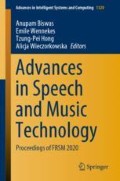Abstract
As there is aggrandizement in the sector of artificial intelligence relating to the speech domain, it becomes a necessity to have efficient noise removal models with greater efficiency and less complexity. The presence of noise in audio signals poses a great complication when working on speech recognition, enhancement, improvement, and transmission. Hence, there is a necessity to develop the most efficient algorithm for noise reduction which works in real time and is successful in removing maximum noise. To be above this difficulty, this paper presents an efficient algorithm for noise detection which works on the principles of deep learning, specifically convolutional neural networks (CNNs) and the removal of similar noise from the audio using the Python module ‘noise reducer.’
Access this chapter
Tax calculation will be finalised at checkout
Purchases are for personal use only
References
Constant-q transform and chroma. https://musicinformationretrieval.com/chroma.html
librosa.feature.chroma_stft. http://man.hubwiz.com/docset/LibROSA.docset/Contents/Resources/Documents/generated/librosa.feature.chroma_stft.html
librosa.feature.melspectrogram. http://man.hubwiz.com/docset/LibROSA.docset/Contents/Resources/Documents/generated/librosa.feature.melspectrogram.html
Al-Allaf O (2015) Removing noise from speech signals using different approaches of artificial neural networks. Int J Information Technol Comput Sci 7:8–18. https://doi.org/10.5815/ijitcs.2015.07.02
Ali MA, Shemi PM (2015) An improved method of audio denoising based on wavelet transform. In: 2015 international conference on Power, Instrumentation, Control and Computing (PICC), pp 1–6
Baghdasaryan D (2020) Real-time noise suppression using deep learning. https://developer.nvidia.com/blog/nvidia-real-time-noise-suppression-deep-learning/
Chavan O, Kharade N, Chaudhari A, Bhalke N, Nimbalkar P (2019) Machine learning and noise reduction techniques for music genre classification. Mach Learn 6(12)
Contributors W (2020) Convolution; wikipedia, the free encyclopedia. https://en.wikipedia.org/w/index.php?title=Convolution&oldid=975151751. Online. Accessed 6 Sept 2020
Contributors W (2020) Noise reduction, wikipedia the free encyclopedia. https://en.wikipedia.org/w/index.php?title=Noise_reduction&oldid=967676491. Online. Accessed 6 Sept 2020
Contributors W (2020) Sound masking; wikipedia, the free encyclopedia. https://en.wikipedia.org/w/index.php?title=Sound_masking&oldid=965358994. Online. Accessed 6 Sept 2020
Contributors W (2020) White noise; wikipedia, the free encyclopedia. https://en.wikipedia.org/w/index.php?title=White_noise&oldid=975542178 Online. Accessed 6 Sept 2020
Gartzman D (2020) Getting to know the mel spectrogram. https://towardsdatascience.com/getting-to-know-the-mel- spectrogram-31bca3e2d9d0
Germain FG, Chen Q, Koltun V (2018) Speech denoising with deep feature losses
Godsill SJ, Tan CH (1997) Removal of low frequency transient noise from old recordings using model-based signal separation techniques. In: Proceedings of 1997 workshop on applications of signal processing to audio and acoustics, p 4
Hui J (2019) Speech recognition-feature extraction mfcc & plp. https://medium.com/@jonathan_hui/speech-recognition-feature-extraction-mfcc-plp-5455f5a69dd9
Murphy J, Godsill S (2011) Joint bayesian removal of impulse and background noise. In: 2011 IEEE International Conference on Acoustics, Speech and Signal Processing (ICASSP), pp 261–264
Prasadh SK, Natrajan SS, Kalaivani S (2017) Efficiency analysis of noise reduction algorithms: analysis of the best algorithm of noise reduction from a set of algorithms. In: 2017 International Conference on Inventive Computing and Informatics (ICICI), pp 1137–1140
Wolfe P, Godsill S, Ng WJ (2004) Bayesian variable selection and regularization for time-frequency surface estimation. J Royal Stat Soc Ser B 66:575–589. https://doi.org/10.1111/j.1467-9868.2004.02052.x
Zoican S (2010) Audio signals noise removal real time system, pp 25–28. https://doi.org/10.1109/ICCOMM.2010.5509098
Author information
Authors and Affiliations
Editor information
Editors and Affiliations
Rights and permissions
Copyright information
© 2021 The Author(s), under exclusive license to Springer Nature Singapore Pte Ltd.
About this paper
Cite this paper
Dogra, M., Borwankar, S., Domala, J. (2021). Noise Removal from Audio Using CNN and Denoiser. In: Biswas, A., Wennekes, E., Hong, TP., Wieczorkowska, A. (eds) Advances in Speech and Music Technology. Advances in Intelligent Systems and Computing, vol 1320. Springer, Singapore. https://doi.org/10.1007/978-981-33-6881-1_4
Download citation
DOI: https://doi.org/10.1007/978-981-33-6881-1_4
Published:
Publisher Name: Springer, Singapore
Print ISBN: 978-981-33-6880-4
Online ISBN: 978-981-33-6881-1
eBook Packages: Intelligent Technologies and RoboticsIntelligent Technologies and Robotics (R0)

